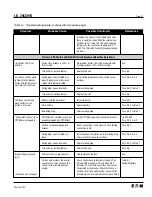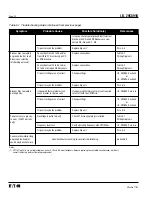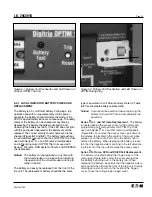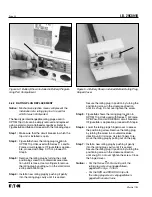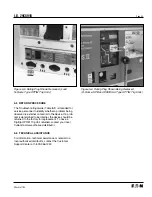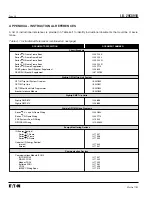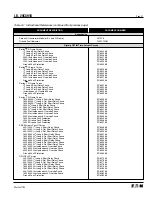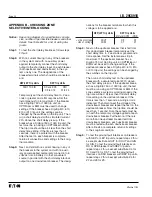
I.B. 29C891B
Page 58
Effective 11/98
APPENDIX B - CHECKING ZONE
SELECTIVE INTERLOCKING
Notice:
See wiring diagrams for specifications on wire
size, number of permissible breakers and other
details. See Table
A.1
for a list of wiring dia-
grams.
Step 1:
To test the short delay interlocks, follow steps
2 thru 4.
Step 2:
With no current flowing in any of the breakers
in the system and with no auxiliary power
applied, temporarily connect the short delay
output to the short delay input on each breaker
(both upstream and downstream) in the sys-
tem one by one. The designations of the
breaker terminals which should be connected
are:
NEP/LEP Trip Units
REP Trip Units
SOUT TO SIN
RD and SPB
DSII
D9 to D10
Z2 to Z3
Temporarily set the short delay time to .2 sec-
onds or greater and a flat response. Set the
instantaneous trip to maximum. If the breaker
has a Digitrip 750 or 1050 trip unit, an
OPTIMizer or BIM must be used to change
settings. If the breaker has a Digitrip 510, 610,
810 or 910 trip unit, the settings can be
changed by the switches on the trip unit. Then
run a short delay test with a simulated current
20% above the short delay pick up. If the
breaker has a Digitrip 750 or 1050 trip unit, the
test must be run using an OPTIMizer or BIM.
The trip time should be a bit less than the short
delay time setting. If the time is less than .1
seconds, there is a problem with the breaker.
After the test on each breaker is complete,
return all connections and settings to their orig-
inal condition.
Step 3:
Next, and still with no current flowing in any of
the breakers in the system and with no auxil-
iary power applied, temporarily connect 5 to 6
volts dc from a battery or other convenient
source in parallel with the short delay interlock
output on one downstream breaker. The desig-
nations for the breaker terminals to which this
voltage is to be applied are:
NEP/LEP Trip Units REP Trip Units
(RD and SPB)
(DSII)
+ side of voltage
SOUT
D9
Z2
- side of voltage
COM
C1
Z1
Step 4:
Next on the upstream breaker that is fed from
this downstream breaker temporarily set the
short delay time to .2 seconds or greater and a
flat response. Set the instantaneous trip to
maximum. If the upstream breaker has a
Digitrip 750 or 1050 trip unit, an OPTIMizer or
BIM must be used to change settings. If the
upstream breaker has a Digitrip 510, 610, 810
or 910 trip unit, the settings can be changed by
the switches on the trip unit.
Then run a short delay test on the upstream
breaker with a simulated current 20% above
the short delay pick up. If the upstream break-
er has a Digitrip 750 or 1050 trip unit, the test
must be run using an OPTIMizer or BIM. If the
zone selective system is working properly, the
trip time will be a bit less than the short delay
time setting on the upstream breaker. If the
time is less than .1 seconds, a wiring error is
indicated. Then disconnect the voltage at the
downstream breaker and repeat the test on the
upstream breaker. Now the trip time should be
less than .1 second. Note these tests must be
run with the temporary voltage applied at each
downstream breaker. Furthermore, if there is
more than one upstream breaker fed from
downstream breakers, each upstream breaker
must be tested with each downstream breaker.
After all tests are complete, return all settings
to their original condition.
Step 5:
To test the ground fault interlocks on breakers
with NEP or LEP trip units, repeat steps 2 thru
4 except substitute GOUT for SOUT and GIN
for SIN. To test the ground fault interlocks on
RD or SPB breakers with REP trip units,
repeat steps 2 thru 4 except substitute C4 for
D10 and C5 for D9. To test the ground fault
interlocks on DSII breakers with REP trip units,
repeat steps 2 thru 4 except substitute Z4 for
Z2 and Z5 for Z3.
Summary of Contents for Digitrip OPTIM 1050
Page 7: ......








